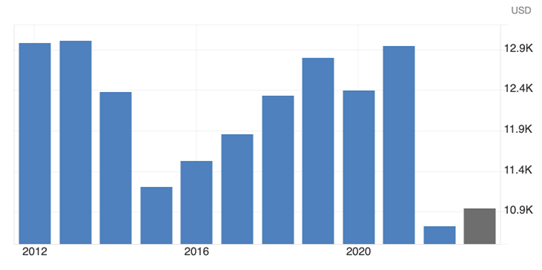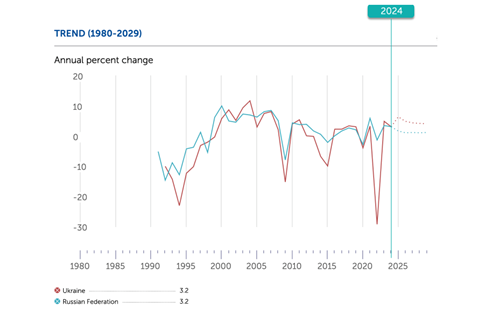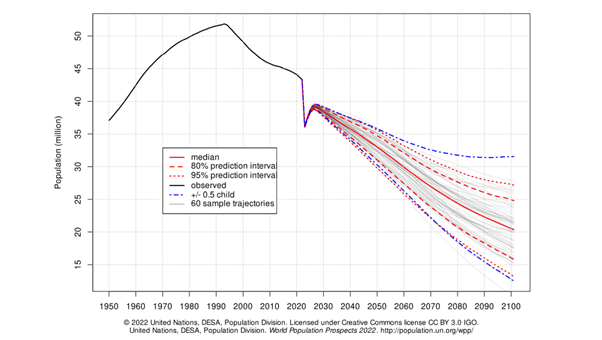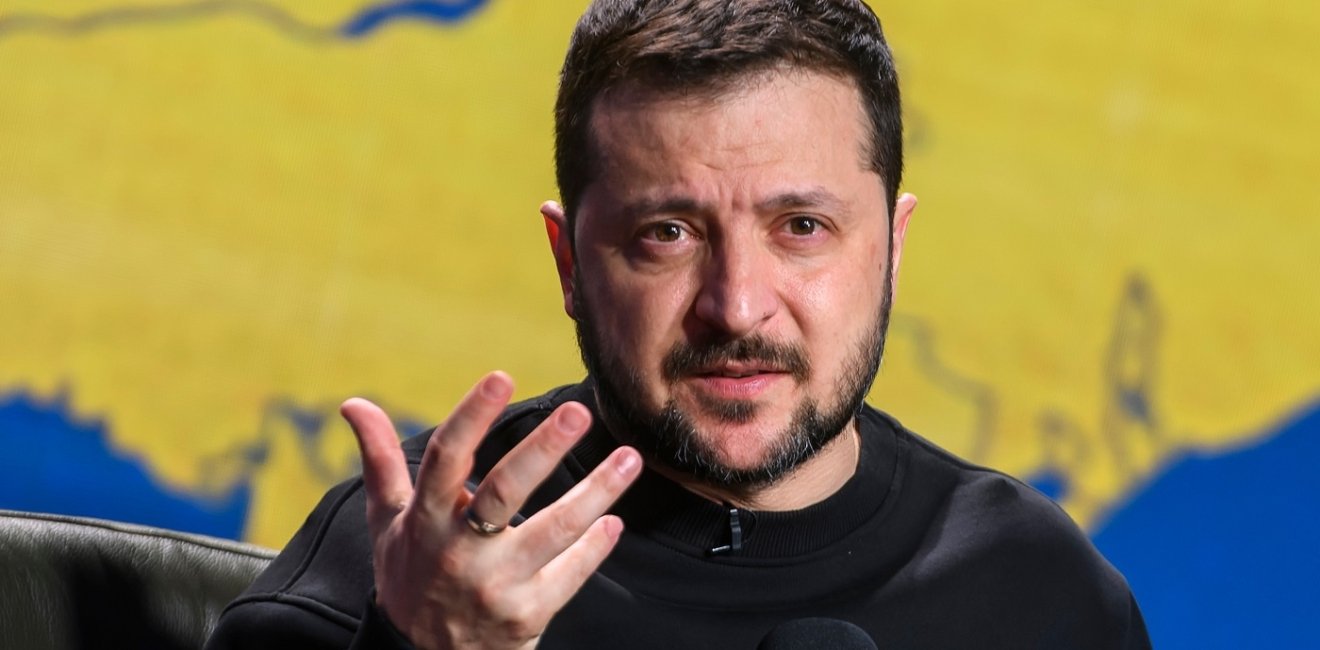
A blog of the Kennan Institute
May 20, 2024, marked the end of President Volodymyr Zelensky’s fifth year in office. Until the next election, which, deferred for now, may occur once martial law is lifted, Zelensky will continue to serve as Ukraine’s president. This anniversary of his inauguration offers an opportune moment to step back and consider the path he, his team, and all of Ukraine have traveled together so far.
Ukraine’s post-Soviet history was full of both glorious and tragic events. But even against this rich background, Zelensky’s term in office stands out. It started with an unusual electoral unity of Ukrainians around the young leader and his come-out-of-nowhere party, which promised to end the war, the oligarchs’ rule, and poverty. It continued under growing pressures from outside, mainly from Russia and separatists, and inside, especially from a multitude of opposition factions and pandemic-related social issues. The thirtieth anniversary of Ukraine’s independence was celebrated on his watch. And after Russia’s large-scale invasion of Ukraine, this presidency turned into a wartime leadership that started with a bang, with the unifying and unprecedented “Zelensky effect,” leavened only by some recent disenchantment with him.
During his enormously difficult five-year term, Volodymyr Zelensky reinvented himself and his program several times. What can be said about his presidency’s achievement so far, and how might his legacy be seen in future?
Zelensky Made Three Promises in 2019. Have They Been Fulfilled in 2024?
Candidate Zelensky made three major promises to voters, who gave him 73 percent of the vote in the 2019 presidential elections. In those days, Zelensky’s voters expected him to achieve peace with Russia in the Donbas, put in place good governance after the disappointing presidency of his predecessor, Petro Poroshenko, and improve the well-being of ordinary Ukrainian families.
The first expectation was not fulfilled. Initially President Zelensky managed to achieve a cease-fire in the Donbas. But the Minsk Process did not advance after the Paris Summit in December 2019. And on February 24, 2022, the Russian Federation invaded Ukraine, turning the military conflict in the Donbas into a full-fledged war. The current peace plan Zelensky has proposed envisages a cessation of hostilities and the withdrawal of Russian troops from all Ukrainian territories. Today, however, despite broad international support, the plan seems to be far from realization.
The path to installing the good governance Ukraine wanted would entail a decrease in oligarchic control and the end of corruption in the public sector. It is safe to say that the political influence of the established oligarchs on Ukrainian politics is minimal these days. However, this reduced influence has not yet translated into stable good governance practices or an effective anti-corruption system. Despite all efforts of the government and the wartime need for resources to be concentrated on national defense, corruption still undermines public sector efficacy.
When Volodymyr Zelensky entered office, the Ukrainian GDP per capita, when adjusted by purchasing power parity (GDP PPP), was recorded at approximately $12,800. Despite the pandemic’s negative influence on economic development, in 2021 the GDP PPP had almost returned to the pre-Euromaidan level of $13,000. With the ongoing war against Ukraine, this index fell below $11,000 (projected) in 2023—which is nonetheless an extraordinary achievement when compared with the GD PPP of other countries in the second year of a war of attrition.
Graph 1. Ukraine’s GDP per capita PPP (real and projected, 2012–2023)

Source: World Bank: Trading Economics
In sum, Zelensky was not able to deliver fully on his campaign promises, given the unexpected curves of history since 2019. However, there is evidence that he has adhered to his electoral program.
The Bigger Picture
Another way to evaluate Zelensky’s presidency is to look at how his achievements fit into a bigger picture of Ukraine’s historical path.
Zelensky is the sixth Ukrainian president since independence—and the fifth president to have to deal with Russia’s Putin. Their first and final personal encounter in Paris in December 2019 started a long duel. After an attempt to find a solution to the Donbas and Crimea issues, their relations turned into open hostility in 2020–2021. In 2022, Zelensky stood up to the challenge of Putin’s full-scale invasion, comparing himself to David fighting Goliath. Since then, and right up to Putin’s recent remarks challenging Zelensky’s legitimacy, this personal combat between two heads of state has raised the stakes almost on a daily basis.
From a Hegelian perspective, however, these two leaders represent a more general struggle of principles in Eastern Europe and northern Eurasia: a free republic versus tyranny. This philosophical framework is hugely important for all European and Eurasian nations’ free future. And this construal of current events places an equally huge responsibility on President Zelensky to preserve liberties and rights in Ukraine during the war.
Once the Russian invasion of Ukraine turned into a war of attrition, it ceased to be a battle that could be couched in terms of armies and leaders. Rather, it is an existential conflict, the end result of which depends on the economy and demography of both Ukraine and Russia.
With respect to the economy, Ukraine is in dire straits. Its GDP was worth almost $200 billion in 2021. In 2022, it fell to $160.50 billion; for 2023, World Bank experts expect it to rise to only $163.71 billion. Simultaneously the Russian economy, after some drop in 2022 as the Western sanctions took effect, continued to grow: Russia’s GDP for 2023 is projected to be $2.250 billion. Even though IMF experts anticipate hardships and very problematic growth for Russia’s economy in the near future (Graph 2), the Kremlin’s ability to resist (and circumvent) sanctions and to use ramped-up military production to buttress the economy is worrisome. Ukraine’s and Russia’s GDP growth is one of the key dimensions of the ongoing war.
Graph 2. Ukraine’s and Russia’s GDP growth (real and projected, 1980–2029)

Source: IMF
The “generals” leading the Ukrainian and Russian economies are among the key figures in this war, just as the economic alliances both sides nurture have become critically important to the outcome of the war. So far, Zelensky’s administration has not achieved a military alliance with Western states but has managed to bring Western economies into Ukraine’s industrial rear. Furthermore, the Ukrainian government tries to use Western support to develop its own military-industrial capacity. Despite many opposing currents, Zelensky is attempting to prepare the Ukrainian economy for long-term resilience.
Finally, this war is the dramatic fight of two, unequal in size peoples. Ukraine, whose current population is probably four to five times smaller than Russia’s, needs an extremely carefully thought-out and smart demographic policy.
Graph 3. Ukrainian population (real and predicted, 1950–2100)

Source: UN DESA
The government uses every means at its disposal to engage the male population in the ranks of the active-duty army. For this reason, despite the political risks involved, President Zelensky signed a controversial act on mobilization. The decision to overstretch the “demographic forces” of Ukraine shows the president’s dedication to winning this war, and to risk not only his political future but also the fate of the national population (Graph 3).
Ukrainian history and the history of the broader Eastern European region did not stop on May 20, 2024. Volodymyr Zelensky is one of those who personally participate in weaving its fabric. And in time, there will be a moment when his legacy can be assessed clear-sightedly and with greater understanding of how decisions and events played out.
The opinions expressed in this article are those solely of the author and do not reflect the views of the Kennan Institute.
Author


Kennan Institute
The Kennan Institute is the premier US center for advanced research on Eurasia and the oldest and largest regional program at the Woodrow Wilson International Center for Scholars. The Kennan Institute is committed to improving American understanding of Russia, Ukraine, Central Asia, the South Caucasus, and the surrounding region through research and exchange. Read more

Explore More in Focus Ukraine
Browse Focus Ukraine
Talking to the Dead to Heal the Living

Ukrainian Issue in Polish Elections


